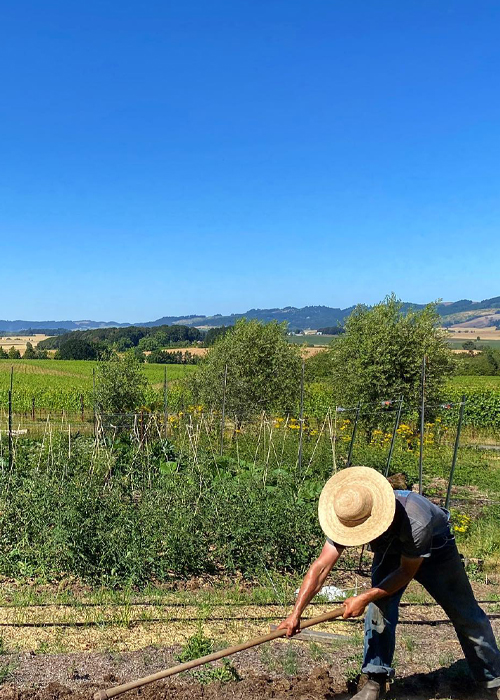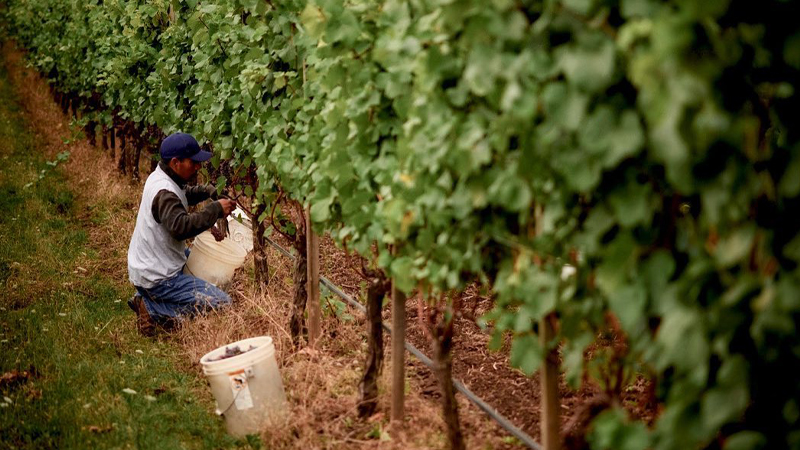When buses of tourists descend on Oregon’s lush Willamette Valley, the selfie-snapping masses invariably come in search of the same grape. Pinot Noir is the region’s most famous varietal, and for good reason: The thin-skinned grape thrives in Willamette Valley’s mild year-round climate, which boasts cool, wet winters and summers that are reliably warm and dry — perfect for producing expressive Pinot Noirs of various styles. But the Willamette Valley is still nascent as wine regions go, only officially established in 1983. A growing chorus of vintners say there’s still much to learn about what grapes might prosper there. What characteristics might such fruit reveal when grown in Oregon’s varied soils, which range from windblown silts to basalt-rich volcanic earth? The only way to find out, they say, is to plant vines and see what happens.
Over the last decade, a handful of Willamette Valley winemakers have broken from the Pinot Noir pack, experimenting with lesser-known varietals with promising success. Will these relatively obscure selections give the region’s signature grape a run for its money? Here are some of the top non-Pinot Noir grapes to watch in the Willamette Valley.

Zweigelt
The dark-berried Zweigelt is Austria’s most planted red grape and known for the softly spicy, fruit-forward wine it produces. Hardy and high-yielding, Austrian Zweigelt can make vintages ranging from light and fresh to rich and oaky. In downtown Carlton, Craft Wine Co. created its first vintage of pure Zweigelt in 2018 and a second in 2019, made with grapes grown at nearby certified-Biodynamic Johan Vineyards. Winemaker Laura Cusick says that the decision to work with the grape is a “nod to the experimental nature of the pioneers of the Oregon wine industry” and a statement that the Willamette Valley is “perhaps too young to limit itself to a specific primary grape.”
Don’t miss a drop!
Get the latest in beer, wine, and cocktail culture sent straight to your inbox.
The effort paid off. “It has been my favorite red wine in our lineup both of those years — always light and low in alcohol, but with plenty of body and depth,” she says. In 2020, Cusick chose not to make any red wines because of concerns about smoke taint, but she hopes to make more pure Zweigelts going forward.
How does Willamette Valley Zweigelt differ from its Austrian counterpart? Cusick said the Van Duzer effect, which funnels cool air in from the Pacific and drops temperatures sharply in the afternoons and evenings, delivers salinity and a distinct savoriness. “For me, this enhances the depth and rustic quality of the wines produced, while still being a typical expression of Zweigelt,” she says, noting the fruit’s high acidity, brightness, and soft and silky tannins.
“There’s absolutely no reason to limit ourselves to Pinot Noir as the sole red-wine-producing grape,” Cusick concludes. “There is so much potential for diversity across this valley.”
Pinot Meunier
In France, you’ll rarely find black-red Pinot Meunier namechecked on labels, but it’s a key ingredient in Champagne blends. In the Willamette Valley, however, James Rahn of James Rahn Wine Company is helping the variety step into the limelight.
“I don’t do any blending,” says Rahn, who made his first standalone Pinot Meunier bottling in 2015. “It’s a close cousin of Pinot Noir, but it’s structured differently — it’s a little bit brighter … I just fell in love with it,” Rahn says.
Rahn’s journey to Pinot Meunier started with a desire to stand out from the crowd, but also a fear of making subpar Pinot Noir. “It’s really difficult to make good Pinot Noir, and because of that, mediocre Pinot Noir just sucks,” he muses. “It’s not like a big Syrah that has a larger margin of error, and so I quickly decided that I didn’t want to make Pinot Noir.” Rahn reasoned that Pinot Meunier was similar enough to Pinot Noir that it would find an audience, but different enough that it would stand out.
Rahn’s Pinot Meunier bottlings are tarter and deeper than Pinot Noir, with a balance of savory and sweet notes and a hit of spice. Last year, he also made a white wine with Pinot Meunier — “it turned out so cool, I’m going to do that every year now” — and now has four acres of the grape planted at Abbey Road Farm, where he serves as the director of winemaking.
“I have 16 varieties on my 43 acres. I do have some Pinot Noir [and] I do have some Chardonnay, but then I have all these other juicy grapes that hardly anybody has heard of,” Rahn says. “I find myself part of the movement to sort of diversify the Willamette Valley.”

Arneis
Hailing from the Piedmont region in northwest Italy, Arneis is an aromatic white grape with low acidity. The grape’s profile rose in Italy beginning in the 1980s, but it remains a rare sight stateside — except, that is, at Ponzi Vineyards in the Chehalem Mountains.
Luisa Ponzi, Ponzi Vineyards’ second generation winemaker, said that her father, Dick Ponzi, had fallen head over heels for the grape years ago while in Piedmont visiting friends, the Currado family of Vietti Winery. Vietti had been pivotal in bringing Arneis back from the brink of obscurity in Italy, seeing for the first time its commercial potential as an interesting, distinctive white varietal. Dick Ponzi agreed.
“It was a passion project for my father initially,” Luisa Ponzi says. He realized that in Piedmont, Arneis tended to be planted in cooler areas not dissimilar to the Willamette Valley. He carried Arneis cuttings home in his suitcase, ultimately planting five acres in the early 1990s.
Fast forward to today: Ponzi Vineyards’ Arneis bottlings deliver notes of pear and wet rock with a rollicking acidity and richness. “It’s turned out to be a consistently really interesting and different unique wine,” Ponzi says — different even from the Arneis plantings in Piedmont. “We tend to get a much bigger, fruitier style of wine [with] a lot more dried fig and marzipan and really complex aromatics.”
“It consistently gets perfectly ripe here,” she continues. “It’s amazing to me that not more people have planted this varietal, because I find it just completely appropriate for our climate.”
Will Pinot Noir continue to dominate the Willamette Valley? Although it will certainly continue to be a major player, Ponzi thinks change is afoot. “Fifty years ago, this valley was really at the edge of what you could do for grape growing, because it was so cool,” she reflects. The region’s climate, however, has gradually warmed. “I never thought I could grow Nebbiolo here, ever — and the last five years it’s gotten ripe,” she says. If she were starting a new vineyard today, Ponzi admits she might still plant a majority of Pinot Noir. But things are changing. “There’s no question that there’s kind of this new frontier of like, ‘What else can we do?’”


